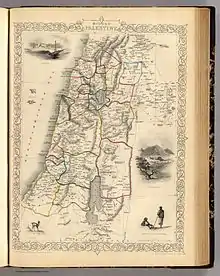Timeline of the history of the region of Palestine
Timeline of the history of Palestine is a timeline of major events in Palestine. For more details on the history of Palestine see History of Palestine. In cases where the year or month is uncertain, it is marked with a slash, for example 636/7 and January/February.
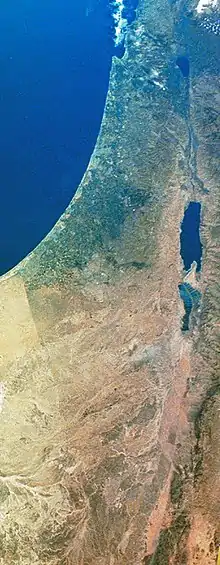
Prior to the 2nd millennium BCE

- c. 65 to 70 million BCE – A Prognathodon died in the Negev region; its complete skull was discovered in a phosphate mine in the Negev in 1993.[1][2]
- c. 380,000–200,000 BCE – The Qesem Cave was occupied by prehistoric humans.[3]
- c. 9000 BCE Natufian hunter-gatherer groups form a permanent settlement that would come to be known as Jericho
2nd millennium BCE
- c. 1469 BCE – In the Battle of Megiddo, Egyptian forces under the command of Pharaoh Thutmose III defeat a large Canaanite coalition under the king of Kadesh.[4]
1st millennium BCE
- 925 BCE – Sack of Jerusalem (925 BC) – Pharaoh Sheshonk I of the Third Intermediate Period invades Canaan following the Battle of Bitter Lakes. Possibly the same as Shishak, the Pharaoh mentioned in the Bible in the book of Kings 1, who captured and pillaged Jerusalem (1 Kings 14: 25).
- 853 BCE – The Battle of Qarqar in which Jerusalem's forces were likely involved in an indecisive battle against Shalmaneser III of Neo-Assyria (Jehoshaphat King of Judah was allied with Ahab King of the Israel according to the Jewish Bible).[5]
- c. 720 BCE – The Kingdom of Israel is conquered by Neo-Assyrian Empire and parts of the local population is deported and replaced with deportees from other parts of the empire.[6]
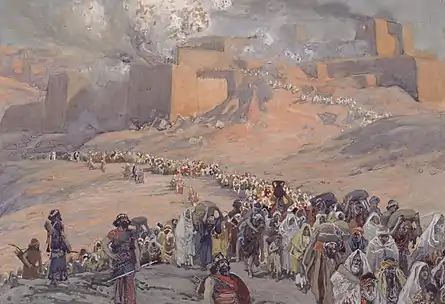 The Babylonian captivity (painting by James Tissot from c. 1896 to 1902)
The Babylonian captivity (painting by James Tissot from c. 1896 to 1902)
Hellenistic period
The Hellenistic period began with Alexander the Great's conquest of Palestine in 323 BCE and ended with Pompey's conquest of Palestine in 66 BCE.
- c. 260 BCE - Beit She'an is refounded as the poleis Scythopolis by Ptolemy II Philadelphus.[7]
- 200 BCE - The Seleucid emperor Antiochus III the Great conquers Palestine.[8]
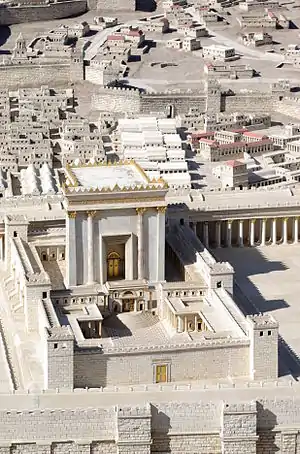 Model of the Second Temple at the Israel Museum
Model of the Second Temple at the Israel Museum - 175 BCE:
- Seleucus IV (r. 187 BCE – 175 BCE) dies and is succeeded by Antiochus, son of Seleucus IV.[9]
- Antiochus IV Epiphanes (r. 175 BCE – 164 BCE) becomes the Seleucid emperor.[10]
- 174 BCE - Antiochus appoints Jason as high priest of the Jerusalem Temple.[11]
- 172 BCE - Antiochus replaces Jason with Menelaus as high priest of the Jerusalem Temple as the latter offers to pay a much bigger tribute.[12]
- Late 170 BCE/Early 169 BCE - Antiochus invades Egypt but decides to return. Perhaps because of disturbances in Palestine. His return is triumphant and he brings many spoils.[13]
- Autumn 169 BCE - On his way back from Egypt, Antiochus raids the Jerusalem Temple and confiscates its treasures.[14]
- Spring 168 BCE - Antiochus invades Egypt but the Romans force him to withdraw.[15] Meanwhile, rumors spread in Judea that the king has died and Jason launches a surprise attack on Jerusalem, captures the city, and kills supporters of his rival Menelaus.[16] Antiochus interprets Jason's attack as a rebellion and sends an army that retakes Jerusalem and drives Jason's followers away.[17]
- Autumn 167 BCE - Antiochus IV Epiphanes outlaws Judaism in Judea and allows pagan worship at the Jerusalem temple.[18]
- Spring 165 BCE - Antiochus campaigns against the Parthians.[19]
- 164 BCE:
- Spring - Antiochus issues a letter repealing the ban on Judaism and promising amnesty for the insurgents who return before March 164. The provincial land-tax from 167 BCE is abolished. The Maccabees does not take up the Seleucids offer and the insurgency continues.[20]
- Summer - The Maccabees carries out a number of punitive expeditions, likely led by Judas, against people who had participated in the persecution against Jews.[21]
- Autumn/Winter - Judas enters Jerusalem and the alter to Zeus and other pagan artifacts are removed from the Temple.[22] Meanwhile, Antiochus dies in Persis,[23] igniting a century-long war of succession in Antioch, the capital of the Seleucid empire.[24]
- 161 BCE - Judas Maccabeus is killed in battle and his army is routed.[25]
- 152 BCE - Jonathan Apphus is appointed high priest of the Jerusalem temple by the Seleucids.[26]
- c. 145 BCE - The Seleucid ruler Demetrius II Nicator lets Judea annex the three three southern Samarian districts Lydda, Aphairema, and Ramathaim.[26]
- 135/4 BCE John Hyrcanus becomes Hasmonean king.[27]
- 129 BCE - The Seleucid emperor Antiochus VII Sidetes dies.[28]
- c. 112-107 BCE - The Hasmoneans destroy the Samaritan temple at Mount Gerizim and devastates Shechem.[29]
- c. 108/7 BCE - The Hasmoneans destroy Scythopolis.[7]
- 104 BCE - Aristobulus I succeds Hyrcanus as king of Judea.[30]
- 103 BCE - Alexander Jannaeus succeeds Aristobulus. He greatly extends the Hasmonean kingdom, concentrating on Greek cities along the Palestinian coast.[31]
- 76 BCE - Hyrcanus II succeeds Alexander Jannaeus.[32]
.jpg.webp)
- 67 BCE:
- Salome Alexandra dies and her son Hyrcanus II becomes king of Judea.[33]
- A war of succession leads to a civil war among the Hasmoneans in Judea.[32]
Roman period
The roman period lasts from Pompey's conquest of Palestine in 66 BCE until Constantine the Great declares Christianity a permitted religion in 313 CE.
- 63 BCE - Roman troops occupies Palestine.[34]
- 57-54 BCE - Scythopolis is rebuilt by the Roman proconsul Gabinius.[7]
- 47 BCE:
- Herod the Great is appointed governor of Galilee.[35]
- Herod clears out Hezekiah's "brigands,"[36] who had been harassing people in southern Syria.
- 40 BCE:
- The Parthians invade Judea, seize Jerusalem and appoint Antigonus II Mattathias King of Judea.
- Herod visits Rome to seek Mark Antony's support.[37] He is appointed king by the Roman senate.[38]
- 37 BCE – Herod the Great conquers Judea with the help of Roman and Jewish troops. Antigonus II Mattathias, who had barricaded himself in the city, is beheaded by Mark Antony.[39]
- 31 BCE – 31 BC Judea earthquake. A powerful earthquake occurs in Judea.[40]
- 27 BCE – King Herod rebuilds Samaria and renames it Sebastia.[41]
- 23 BCE – King Herod builds a palace and fortress called Herodium, about 7.5 miles (12 km) south of Jerusalem.[42]
- 22 BCE - Herod begins construction of a new city and harbor called Caesarea Maritima at the old settlement Straton's Tower.[43]
- 20 BCE
- 19 BCE – King Herod the Great further extends the Temple Mount's natural plateau and rebuilds the temple.[46]
- c. 10 BCE - Caesarea is completed.[47]
- 7 BCE - Herod has his two sons Alexander and Aristobulus executed.[48]
- 7–2 BCE – Birth of Jesus.[49]
- 4 BCE – Herod dies and a wave of unrest sweeps Palestine.[50]
- 6:
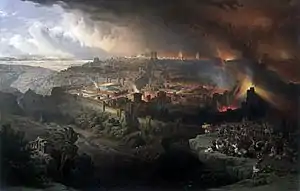
- c. 20 - Tiberias in the Galilee is founded by Herod Antipas, one of Herod the Great's succors.[53]
- 26–33 – Jesus is crucified.
- 37 - Herod Philip dies.[54]
- 39 - Antipas is removed from his post and banished to Gaul. Herod Agrippa I receives his territories.[54]
- 41 - Agrippa I becomes king of parts of the Herodian kingdom that in 6 CE had been divided by Herod's sons.[55]
- 44 - Herod Agrippa I dies.[56] Judea comes under direct Roman administration.[57]
- 62-4 - The renovations of the Jerusalem temple begun by Herod are completed.[58]
- 66-70 - First Jewish revolt:[59]
- 66 - The revolt breaks out in the summer.[60]
- 67 - Roman legions invade Palestine.[60]
- 69 - Vespasian is declared emperor and leaves for Rome. His older son Titus takes command of the Roman legions in Palestine.[57]
- 70 - The Romans takes Jerusalem and destroys the Second Temple.[61]
- 73/4 - The Romans takes Masada, the last rebel holdout.[62]
- 70/1 - Provincia Iudaea is established.[63]
- 106 - The Romans annexes Nabataean territory and reorganizes it as the province of Arabia.[64]
- 120 - First imperial road built through the Galilee.[65]
- 129/130 - The Roman emperor Hadrian visits Syria, Palestine, and Arabia[66] and founds the Roman colony Aelia Capitolina at Jerusalem.[67] Presumably, the outbreak of the Bark Kokhba revolt is directly linked to this event.[68]
- 132–135 – Bar Kokhba revolt:[69]
- 195 - The bishops of Caesarea and Jerusalem, Theophilus and Narcissus presides over a council in Caesarea to settle a growing dispute over the proper date of the celebration of Easter.[70]
- 222 - Caesarea becomes the metropolitan see for Palestine.[71]
- 270 – Zenobia ruler of the Palmyrene Empire conquers most of the Roman east including Palestine.
- 272 – Palestine is recaptured by Rome.
Byzantine period

The Byzantine period lasts from 313 when Constantine declares Christianity a permitted religion to the Muslim conquest of Palestine in 637-640.
- 313 - The Roman Emperor Constantine the Great declares that Christianity is an acceptable religion.[72]
- 324 – Constantine, having defeated Emperor Maximian, Caesar of the Western Roman Empire at the Battle of the Milvian Bridge becomes the sole ruler of the re-united Roman Empire with its capital at Byzantium (New Rome). Queen Helena, a devout Christian, wife of Eastern Roman Emperor Constantius and mother of Constantine the Great, departs for the Holy Land and begins the construction of churches.
- 326–333 – Concurrent construction of the world's first 4 church buildings under Helena's Tutelage: The Church of the Nativity is built in Bethlehem, marking the site where according to Christian tradition Jesus was born; "Eleona" (Greek: Olive) on the Mount of Olives in Jerusalem also called "Chapel of The Apostles" marking the site where according to Christian tradition Jesus ascended to heaven; The Church of The Holy Cross, later called The Church of the Holy Sepulchre is built in Jerusalem on the hill of Golgotha marking the site where according to Christian tradition Jesus was crucified, buried and resurrected; Mamre, near Hebron.
- c. 350- The Christian monk Hilarion founds the first church in Haluza and converts a large portion of the population.[73]
- 351/2 – Jewish revolt centered around Sepphoris against the Caesar of the Byzantine (Eastern Roman) Emperor Constantius Gallus. The revolt is quickly subdued by Gallus' general Ursicinus.[74]
- c. 357 - Palestine is divided into the provinces Palaestina Prima and Palaestina Salutaris.[75]
- 361-3 – Roman emperor Julian the Apostate orderes Alypius of Antioch to rebuild the Jewish Temple.[76]
- 363 – An earthquake with its epicenter in the Galilee rocks Palestine.[77] The earthquake results in, among other things, a halt in the construction of the Jewish Temple, mainly because it ruins the early stages of the construction. Eventually the plan to rebuild the Temple is scrapped after the death of emperor Julian in June 363.
- 374/5 - Melania the Elder founds a monastery on the Mount of Olives which also functions as a hostel for pilgrims.[73]
- c. 400 - Palestine proper is split into the provinces Palaestina Prima and Palaestina Secunda. Palaestina Salutaris is renamed Palaestina Tertia.[78]
- 425 – The Sanhedrin is disbanded by the Byzantine Empire.
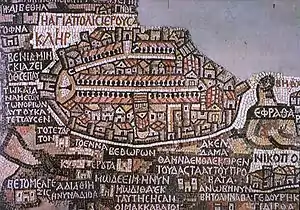
- 438-9 - Empress Aelia Eudocia Augusta visits Jerusalem for the first time.[79]
- 451 - The Council of Chalcedon declares that Jerusalem shall be a patriachate.[80]
- 484 - Samaritans revolt as Emperor Zeno has church built on their holy mountain Gerizim.[81]
- 529 - The Samaritans rebels against the Romans.[82] Samaritanism loses its religio licita status as punishment.[83]
- 541/2 - The bubonic plauge sweeps Palestine.[7]
- 555/6 - Uprising by Samaritans and Jews centered around Caesarea.[84]
- 571 - Muhammad, founder of Islam, is born in Mecca.[72]
- 613 - The Sasanian Empire (Persian Empire) captures several Palestinian cities on the coast.[85]
- May 614 – The Sasanian Empire under general Shahrbaraz captures and sacks Jerusalem;[85] the Church of the Holy Sepulchre is damaged by fire and the True Cross is captured.[85]
- 629 – Byzantine Emperor Heraclius retakes Jerusalem, after the decisive defeat of the Sassanid Empire at the Battle of Nineveh in 627. Heraclius personally returns the True Cross to the city.[86]
- 4 February 634 - The Rashidun Caliphate defeats a Byzantine 300-man-strong force led by Dux Sergius at the Battle of Dathin, near Gaza.[87]
Early Muslim period

Rashidun Caliphate
- 637 – Jerusalem falls to the Rashiduns under Caliph Umar Ibn el-Khatab.[88] Jews are permitted to return to the city after 568 years of Roman and Byzantine rule.[89]
- June/July 637 - The Rashiduns capture Gaza.[88]
- Summer 637 - Ascalon surrenders to the Rashiduns.[88]
- Late 637 - The Rashiduns and the Byzantines consent to a truce.[88]
- 640 - The Rashiduns capture Caesarea.[71]
- 659 - Earthquake. [90]
Umayyad Caliphate
- 661 – The Umayyad family takes control of the caliphate and moves its capital to Damascus, following the assassination of the Caliph Ali ibn Abi Talib.[91]
- 687–691 – The Dome of the Rock is built on the Temple Mount in Jerusalem at the site where according to Islam Muhammad ascended to heaven.[72]
- c. 715 - Sulayman ibn Abd al-Malik founds Ramla and it becomes the capital and administrative center of Palestine.[92]
- 744:
- February - Caliph Hisham ibn Abd al-Malik dies and is succeeded by Al-Walid II.[93]
- Spring - Beginning of widespread mutinies against the Umayyads.[93]
- April - Caliph Al-Walid II is assassinated and succeeded by Yazid III.[93]
- October - Yazid III is assassinated and succeeded by Ibrahim ibn al-Walid.[93]
- November Caliph Ibrahim is defeated in battle by Marwan II who becomes the new caliph.[93]
- 745 - Theodore is appointed patriarch of Jerusalem.[93]
- 18 January 749 - The Galilee earthquake destroys Tiberias, Scythopolis, Hippos, and Pella. Many other cities throughout the Jordan valley suffers heavy damage. Tens of thousands of lives are lost.[94][95]
 Scythopolis (Beit She'an) was one of the cities destroyed during 749 Galilee earthquake
Scythopolis (Beit She'an) was one of the cities destroyed during 749 Galilee earthquake
Abbasid Caliphate
- 747-50 – Civil war resulting the overthrow of the Umayyads and the Abbasid family seizing control of the caliphate.[96]
- 758 - The Caliph Al-Mansur visits Jerusalem and maybe orders the renovation of the Dome of the Rock.[97]
- 762 - The Abbasids founds Baghdad and designates it the caliphate's new capital.[98]
- 792/3 - War between the tribes of Palestine[99]
- 796 - Battles between the tribes of Palestine breaks out.[100]
- 799 - The Patriarch of Jerusalem sends a mission to the Frankish king Charlemagne and the latter returns the favor.[101]
- c. 800 - The Jewish High Council headed by Gaon moves from Tiberias to Jerusalem.[102]
- 800 - The Patriarch of Jerusalem sends another mission to Charlemagne carrying the keys to the Church of the Holy Sepulchre, together with a bannar.[103]
- 807 - A rebellion with its epicenter in Eilat and led by Abu'l-Nida' breaks out.[104]
- 813 - Earthquake.[105]
- c. 820 - The Church of the Holy Sepulchre is repaired.[106]
- 820 - Basil is appointed patriarch of Jerusalem.[107]
- 855 - Solomon is appointed patriarch of Jerusalem.[106]
- 885 - The Abbasids reconquer Damascus.[108]
- 873 - The governor of Egypt, Ahmad Ibn Tulun breaks with the Abbasids and establishes independent rule.[108]
- 878 – The Tulunids occupy most of the former Byzantine Diocese of the East, enabling them to defend Egypt against Abbasid attacks.[109]
- 879 - Elias III is appointed patriarch of Jerusalem.[110]
- c. 881 - Elias III of Jerusalem appeals to the Franks.[111]
- c. 903 - The Persian geographer Ibn al-Faqih visits Jerusalem.[112]
- 905/6 – The Abbasids regains control of Palestine.[108]
- 908/9 - Al-Muqtadir forbids Christians from serving in administrative positions.[113]
- c. 913 - The Spanish scholar Ibn Abd Rabbih visits Jerusalem.[112]
- 935 - Ikhshid takes control of Egypt and establishes independent rule.[108]
- 26 March 937 - Rioting Muslims burns down the Church of the Resurrection and loots the Chapel of Golgotha.[114]
- 17 October 939 - Muhammad ibn Ra'iq conquers Ramla.[115]
- Late 939 Battle of al-'Arish between Ibn Ra'iq and the Ikhshid.[115]
- July 946 - Sayf al-Dawla invades Palestine.[116]
- 966 - A Muslim-Jewish mob torches the Church of Resurrection, plunders it, and kills Jerusalem's Patriarch John VII.[117]
Fatimid Caliphate
- 969/70 – The Fatimids, a self-proclaimed Shia caliphate, defeats the Ikhshids and appoints a Jewish governor.[108]
- 971 - The Karmatis attacks Damascus.[108]
- 5 September 971 - The Qarmatis conquers Ramla.[118]
- December 971 - The Fatimids wards off a Qarmatid invasion near Fustat.[118]
- 972 or 975 - The Byzantine emperor John I Tzimiskes leads an expedition that reaches as far south as Caesarea and Tiberias in Palestine.[119]
- Winter 975 - The Turkish officer Alptakin conquers Sidon and slaughters the population.[120]
- Spring 975 - Alptakin conquers Tiberias.[121]
- April 975 - Alptakin conquers Damascus.[121]
- 12 March 977 - Ramla is conquered by the Qarmatis.[122]
- 978 - Joseph II is appointed patriarch of Jerusalem.[122]
- 15 August 978 - A massive Fatimid army defeats Alptakin and the Qarmatians in southern Palestine.[123]
- Winter 978-9 - The Jewish Fatimid general Fadl ibn Salih tries to negotiate with the leader of the Hamdanids, but their leader Abu Taghlib refuses because Fadl is a Jew.[124] He later agrees to negotiations with Fadl who offers him Ramla in exchange for ousting the Jarrahids.[125]
- August 979 - Abu Taghlib launches a failed offensive on Ramla and is taken captive and executed.[125]
- June 981 - Damascus is besieged by a Fatimid army.[122]
- July 981 - The Bedouins, led by the Jarrahids, rebels against the Fatimids.[126]
- 5 July 983 - Damascus is conquered by a Fatimid army.[122]
- 984 - Orestes is appointed patriarch of Jerusalem.[122]
- 24 February 991 - Ya'qub ibn Killis dies.[127]
- 996-8 - Revolt in Tyre. The rebels calls for and receives support from the Byzantines. The Fatimids puts the city under siege and it falls in May 998. The rebel leader is tortured and crucified.[128]
- 1006-7 - The Russian abbot Daniel makes pilgrimage to Palestine.[129]
- 1008 - Caliph al-Hakim bi-Amr Allah forbids Jerusalem Christians from performing the Palm Sunday procession.[105]
- 18 October 1009 – Caliph al-Hakim bi-Amr Allah orders the destruction of the Church of the Holy Sepulchre.[130]
- February 1011-3 - Uprising of the Yemenite Djarrahid Bedouin tribe who seizes Ramla and sets up a mini-caliphate.[131]
- 1012 - Beginning of al-Hakim bi-Amr Allah oppressive decrees against Christians and Jews.[132]
- 4 September 1015 - Earthquake. The dome of the Dome of the Rock collapses.[133]
- 13 February 1021 - Caliph Al-Hakim is assassinated and succeeded by his son al-Zahir.[134]
- September 1024 - Bedouin rebellion erupts over tax-collecting privileges (iqta'a). The Bedouins attacks and loots Ramla and Tiberias.[135]
- 1026-7 - Richard of Verdun makes pilgrimage to Palestine.[136]
- 1027 - A treaty is signed between the Byzantine emperor and the Fatimid caliph, permitting the rebuilding of the Church of the Holy Sepulchre and for Christians who had converted to Islam under duress to return to their former faith. The emperor would also get to designate the patriarch of Jerusalem. In return, the mosque of Constantinople would be reopened.[137]
- 1029 - Anushtakin defeats a Bedouin coalition that challenges Fatimid rule in Palestine and Syria.[138]
- 1032 - Renovations of the Dome of the Rock ordered by Caliph al-Zahir are finished.[139]
- 1033:
- 1047 - The Persian poet and traveler Nasir Khusraw visits Palestine.[142]
- 1063 - The Fatimids strengthen or rebuilds the walls of Jerusalem.[143]
- 1064-5 - The Great German Pilgrimage takes place.[144]
- 1068 - An earthquake destroys Ramla and kills an estimated 15,000.[145]
- 1071 – The Seljuk Turks invades large portions of West Asia, including Asia Minor and the Eastern Mediterranean and captures Ramla and lays siege to Jerusalem.[146]
- 1073 - The Seljuks invade Palestine.[147]
- 1075:
- 1077 - The Seljuks capture Jaffa.[146]
- 1089 - The Fatimids conquer Tyre.[149]
- 1092-5 - Abu Bakr ibn al-Arabi stays in Jerusalem.[150]
- 1093 Muslims in coastal communities bars Christians from entering Palestine.[151]
- 27 November 1095 – Pope Urban II launches the First Crusade at the Council of Clermont with the principal objective — the Catholic reconquest of the sacred city of Jerusalem and the Holy Land and freeing the Eastern Christians from Islamic rule.
- 1098:
Crusader/Ayyubid period
.jpg.webp)
The Crusader/Ayyubid period lasts from 1099 when the Crusaders capture Jerusalem to 1291 when the Kingdom of Jerusalem's last remaining position, Acre was overrun by the Mamluks.
- 1096–1099 – First Crusade and the establishment of the Catholic Kingdom of Jerusalem in Outremer.
- 1099:
- 7 June. The crusaders reach Jerusalem and besieges the city.[153]
- 17 June. A Genoese fleet captures Jaffa.[154][155]
- 15 July. Catholic soldiers under Godfrey of Bouillon, Robert II of Flanders, Raymond IV of Toulouse and Tancred take Jerusalem after a difficult siege, killing nearly every inhabitant.[156]
- 22 July. Godfrey is elected as the ruler of Jerusalem, but he is not crowned king.[157][158]
- 12 August. The Crusaders defeat the Fatimids at the Battle of Ascalon.[159]
 Battle of Cresson (painting from the middle ages)
Battle of Cresson (painting from the middle ages) - Godfrey of Bouillon enters Jaffa.[151]
- 25 December 1100. The Kingdom of Jerusalem is established.[160]
- 1113-1115 - Earthquakes hits the region.[161]
- 1116 - The Latins repair the walls of Jerusalem.[161]
- 23 August 1153. The Franks capture Ascalon, thus completing the conquest of the Western coast of the Mediterranean Sea.[162][163]
- 25 November 1177. Battle of Montgisard: Baldwin IV of Jerusalem and Raynald of Chatillon defeat Saladin.
- 1124 - Crusaders conquer Tyre.[164]
- 1177 - The Latins repair the walls of Jerusalem.[161]
- 1187:
- 1 May – Battle of Cresson: Saladin defeats the crusaders.
- June - Saladin captures Tiberias.[160]
- 4 July – Saladin defeats Guy of Lusignan, King of Jerusalem at the Battle of Hattin.[160]
- 2 October – Saladin captures Jerusalem from Crusaders.[165]
- 28 August 1189 - Guy of Lusignan besieges Acre.[166]
- 1189–1192 – Third Crusade led by the armies of Richard the Lionhearted.
- 1191:
- 8 June - Richard arrives at Acre.[166]
- 12 July - The Muslim garrison at Acre surrenders to the Crusaders.[167]
- 20 August – Richard executes Muslim prisoners from Acre outside the city.[166]
- 7 September – Richard I of England defeats Saladin at the Battle of Arsuf forcing him to retreat with heavy losses.[168]
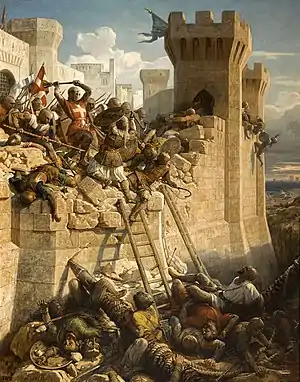 Siege of Acre (painting by Dominique Papety from 1840)
Siege of Acre (painting by Dominique Papety from 1840)
- 1192
- 2 September - Richard and Saladin signs the Treaty of Jaffa, a peace-treaty to run for three years.[169]
- 9 October - Richard leaves Palestine.[170]
- 1193
- 3/4 March. Saladin dies in Damascus. Conflicts between his sons, brothers and nephews cause the disintegration of his empire.[171]
- 1202 - Major earthquake.[172]
- 1219:
- March. The Ayyubid sultan Al-Mu'azzam Isa orders the destruction of Jerusalem's city walls to prevent the crusaders from capturing a fortified city.[173]
- 1229:
- 18 February. Frederick II and the Ayyubid sultan Al-Kamil signs the Treaty of Jaffa, a 10-year-truce (hudna) that restores Jerusalem, Nazareth, and Bethlehem to Christian control in exchange for protection.[174]
- 17 March - Frederick enters Jerusalem.[175]
- 1239 - The Ayyubid ruler An-Nasir Dawud destroys some of the refortifications built by the Franks in Jerusalem.[172]
- 1243 - The Franks recover Jerusalem.[172]
- 1244:
- 11 July - The Khwarizmians under Berke Khan captures Jerusalem and slaughters its inhabitants.[176]
- 18 October - The Crusaders attacks the Khwarizmians north-east of Gaza at the Battle of La Forbie and suffers a crushing defeat.[177]
- c. 1250 Rabbi Yehiel ben Joseph founds a Yeshiva (Jewish religious school) in Acre.[178]
- 1258 - The Mongols execute the last Abbasid caliph.[96]
- 1260 – Battle of Ain Jalut between the Egyptian Mamluks and the Mongols which took place in the Jezreel Valley.
- 1265 – The Mamluk Bahri dynasty of Egypt captures several cities and towns from Crusader states in the Middle East, including the cities of Haifa, Arsuf, and Caesarea Maritima.
- 1267 - According to tradition, Nachmanides visits Jerusalem and establishes the Ramban Synagogue. However, it is doubtful whether Nachmanides ever visited Jerusalem.[179]
- 18 May 1291 – Fall of Acre: Al-Ashraf Khalil of Egypt captures Acre, thus exterminating the Crusader Kingdom of Jerusalem (the final Catholic landholding remaining from the Crusades), and ending the Ninth Crusade.[160]
Mamluk period
The Mamluk period lasts from 1291 when the Mamluks capture Acre to 1517 when the Ottomans capture Palestine.
Ottoman period
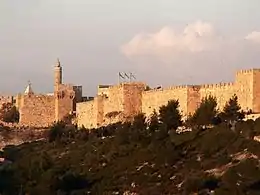
- 1517:
- The Ottomans conquer Palestine.[180]
- 1517 – 1517 Hebron pogrom.
- 1538–1535 – Suleiman the Magnificent restores the Dome of the Rock in Jerusalem and the Jerusalem city walls (which are the current walls of the Old City of Jerusalem).
- 1541 – Ottoman Sultan Suleiman I sealed off the Golden Gate to prevent the Jewish Messiah's entrance.
- 14 January 1546 – A devastating earthquake shook the Jordan Rift Valley region. The epicenter of the earthquake was in the Jordan River in a location between the Dead Sea and the Sea of Galilee. The cities of Jerusalem, Hebron, Nablus, Gaza and Damascus were heavily damaged.
17th century
- 1660 – The towns of Safed and nearby Tiberias, with substantial Jewish communities, were destroyed in the turmoil, following the 1658 death of Mulhim Ma'n,[181] with only Safed being repopulated shortly after the destruction.[182][183] Some sources place the destruction of Safed in 1662.[184]
- 1604 – First Protectorate of missions agreed under the Capitulations of the Ottoman Empire, in which Ahmad I agreed that the subjects of Henry IV of France were free to visit the Holy Places of Jerusalem. French missionaries begin to travel to Jerusalem and other major Ottoman cities.
- 1663-5 – Sabbatai Zevi, founder of the Sabbateans, preaches in Jerusalem before travelling back to his native Smyrna where he proclaimed himself the Messiah
18th century

- 1700 – Judah the Pious with 1,000 followers settle in Jerusalem.
- 1742-1777 - Several Jewish Hassidic leaders (including Rabbi Abraham Gershon of Kitob and Menachem Mendel of Vitebsk ) move to the Holy Land with many followers of the Baal Shem Tov. Historians mark their arrival as the beginning of the current Jewish Hassidic community in the region.
- 30 October 1759 – Another devastating earthquake shook the Jordan Rift Valley region. The epicenter of the earthquake was again in the Jordan River, in a location between the Sea of Galilee and the Hula Valley. The cities of Safed, Tiberias, Acre, Sidon were heavily damaged.
- 1798 – Napoleon Bonaparte leads the French Campaign in Egypt and Syria.
- 3–7 March 1799 – Napoleonic Wars: Siege of Jaffa – Napoleon captures the city of Jaffa.
- 20 March–21 May 1799 – Napoleonic Wars: Siege of Acre – An unsuccessful attempt by Napoleon to capture the city of Acre.
- 8 April 1799 – Napoleonic Wars: Battle of Nazareth
- 11 April 1799 – Napoleonic Wars: Battle of Cana
- 16 April 1799 – Napoleonic Wars: The Battle of Mount Tabor – Napoleon drives Ottoman Turks across the River Jordan near Acre.
19th century
- 1808-1810 - Students of Elijah ben Solomon Zalman (Gr"a) arrive in the Holy Land numbering 501 families. Historians mark their arrival as the beginning of the current Jewish Ashkenazi community in the region.
- 10 May 1832 – Mohammed Ali leading Egyptian forces, and aided by local Maronites, seize Acre from the Ottoman Empire after a 7-month siege.
- 1834 – Peasants' revolt in Palestine - revolt by Arab Palestinian peasants against Egyptian conscription and taxation policies.
- 1 January 1837 – Galilee earthquake of 1837 – A devastating earthquake that shook the Galilee region, killing thousands of people.[185]
- 15 July 1840 – The Austrian Empire, the United Kingdom of Great Britain and Ireland, the Kingdom of Prussia, and the Russian Empire sign the Convention of London with the ruler of the Ottoman Empire. The signatories offered to Muhammad Ali and his heirs permanent control over Egypt and the Acre Sanjak (roughly what is now Israel), provided that these territories would remain part of the Ottoman Empire and that he agreed within ten days to withdraw from the rest of Syria and returned to Sultan Abdülmecid I the Ottoman fleet which had defected to Alexandria. Muhammad Ali was also to immediately withdraw its forces from Arabia, the Holy Cities, Crete, the district of Adana, and all of the Ottoman Empire.
- 1860 – The first Jewish neighborhood (Mishkenot Sha'ananim) is built outside the walls of the Old City of Jerusalem.[186]
- 1874 – Jerusalem becomes a Mutesarrifiyyet gaining a special administrative status.
- 1882–1903 – The First Aliyah took place in which 25,000–35,000 Jew immigrants immigrated to Ottoman Syria.
- 1887-8 – Ottoman Syria was divided into Jerusalem Sanjak, Nablus Sanjak and Acre Sanjak
- 29–31 August 1897 – The First Zionist Congress is held in Basel, Switzerland, in which the World Zionist Organization was founded and the Basel Declaration was approved which determined that the Zionist movement ultimate aim is to establish and secure under public law a homeland for the Jewish people. It is to be located in the Biblical region dubbed variously "The Holy Land" or "Palestine" by the European Christians during the Catholic and later secular Enlightenment.
- 1898 – German Kaiser Wilhelm visits Jerusalem to dedicate the Lutheran Church of the Redeemer. He meets Theodore Herzl outside city walls.


- 1901 – The Jewish National Fund was founded at the Fifth Zionist Congress in Basel with the aim of buying and developing land in the southern region of Ottoman Syria for Jewish settlement.
- 11 April 1909 – Tel Aviv was founded on the outskirts of the ancient port city of Jaffa.
- 1911 - The Arabic newspaper Filasṭīn is founded.[187]
- 26 January to 4 February 1915 – German led Ottoman Army advanced from Southern Palestine, conducted a Raid on the Suez Canal in an attempt to stop traffic through the canal.
- March–October 1915 – The 1915 locust plague breaks out in the Eastern Mediterranean coastal region.
- 1916–1918 – The Arab Revolt
- 16 May 1916 – Britain and France conclude the secret Sykes-Picot Agreement, which defines their respective spheres of influence and control in Western Asia after the expected demise of the Ottoman Empire at the end of World War I. It was largely a trade agreement with a large area set aside for indirect control through an Arab state or a confederation of Arab states.
- 3–5 August 1916 – German led Ottoman Army attack British Empire forces defending the Suez Canal at the Battle of Romani.
- 23 December 1916 – Anzac Mounted Division occupy El Arish and capture Ottoman garrison during the Battle of Magdhaba.
- 9 January 1917 – Sinai and Palestine Campaign: Battle of Rafa – British Empire forces defeat the Ottoman Empire garrison at Rafah after re-capturing the Egyptian Sinai Peninsula by the Egyptian Expeditionary Force.
- 26 March 1917 – Sinai and Palestine Campaign: First Battle of Gaza – British attack strong Ottoman defences at Gaza, failed after 17,000 German led Ottoman troops block their advance in the Southern Coastal Plain.
- 6 April 1917 – Sinai and Palestine Campaign: The Tel Aviv and Jaffa deportation – The Ottoman authorities deport the entire civilian population of Jaffa and Tel Aviv pursuant to the order from Ahmed Jamal Pasha, the military governor of Ottoman Syria during the First World War. Although the Muslim evacuees are allowed to return before long, the Jewish evacuees were not able to return until after the British conquest of Palestine.[188]
- 19 April 1917 – Sinai and Palestine Campaign: Second Battle of Gaza – Ottoman defenders repels the second British assault on Gaza
- 31 October 1917 – Sinai and Palestine Campaign: Battle of Beersheba – XX Corps infantry and Desert Mounted Corps mounted infantry attack and capture Beersheba on the Gaza to Beersheba defensive line on the northern edge of the Negev Desert, from the Ottoman Empire.
- 31 October-7 November 1917 – Sinai and Palestine Campaign: Third Battle of Gaza – British forces capture Gaza.
- 2 November 1917 – The Balfour Declaration is published in which the British Government declares its support for the establishment of a Jewish national home in what is to become Mandate Palestine.
- 15 November 1917 – Sinai and Palestine Campaign: Australian and New Zealand troops capture Jaffa after the Battle of Mughar Ridge fought on 13 November.
- 17 November-30 December 26, 1917 – Sinai and Palestine Campaign: Battle of Jerusalem – The Ottoman Empire are defeated by the British Empire forces at the Battle of Jerusalem. The British Army's General Allenby enters Jerusalem on foot, in a reference to the entrance of Caliph Umar in 637.
- 21 February 1918 – Sinai and Palestine Campaign: Capture of Jericho – begins Egyptian Expeditionary Force Occupation of the Jordan Valley
- 8–12 March 1918– Sinai and Palestine Campaign: Battle of Tell 'Asur – series of attacks along the Jaffa to Jerusalem line which pushed the front line a few miles north.
- 21 March–2 April 1918 – Sinai and Palestine Campaign: First Transjordan attack on Amman including the First Battle of Amman – an infantry and a mounted division invaded Ottoman Empire territory only to be forced by superior Ottoman forces to retreat back to the Jordan Valley.
- 30 April–4 May 1918 – Sinai and Palestine Campaign: Second Transjordan attack on Shunet Nimrin and Es Salt – second attempt to capture Ottoman Empire territory east of the Jordan River when three divisions were again forced back to the Jordan Valley by superior Ottoman defenders.
- June 1918 – First meeting between the Zionist leader Chaim Weizmann and the son of the Sharif of Mecca Hashemite Prince Faisal, who led the Arab forces in the Arab Revolt against the Ottoman Empire during the First World War, which takes place in Faisal's headquarters in Aqaba in an attempt to establish favourable relations between Arabs and Jews in the Middle East.
- 14 July 1918 – Sinai and Palestine Campaign: Battle of Abu Tellul
- 19–25 September – Sinai and Palestine Campaign: Battle of Megiddo including the Battle of Sharon, the Battle of Nablus and the Third Transjordan attack the Egyptian Expeditionary Force attacked and captured large numbers of Ottoman and German soldiers and Ottoman territory. These battles included the capture of Amman, Arara, Capture of Afulah and Beisan, Haifa, Jenin, Nablus, Samakh, Tabsor, Tiberias Tulkarm, including a series of air raids in the Judean Hills when bombs were dropped on retreating German and Ottoman columns.
- 26 September–1 October 1918 – Sinai and Palestine Campaign: Capture of Damascus – continuing the Egyptian Expeditionary Force attacks and captures of almost two Ottoman armies and territory extending into Syria. During this advance Irbid, Jisr Benat Yakub, Kaukab, and Kiswe were captured. The British Empire offensive continued into Syria with the Charge at Khan Ayash and the Pursuit to Haritan including the Battle of Aleppo to end with the Charge at Haritan on 26 October.
- 30 October 1918 – Sinai and Palestine Campaign: The British Sinai and Palestine Campaign officially ends with the signing of the Armistice of Mudros and, shortly thereafter, the Ottoman Empire is dissolved.
Mandatory Palestine
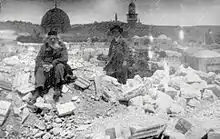
- 11 July 1927 – 1927 Jericho earthquake – A powerful earthquake occurs in the Jordan Rift Valley region.
- 1929 – the outbreak of the 1929 Palestine riots.
- 1936–1939 – The Great Arab Revolt.
- 29 November 1947 – UN General Assembly adopts a resolution containing proposal to divide Mandatory Palestine into independent Arab and Jewish States and a Special International Regime for the city of Jerusalem and its environs.[189]
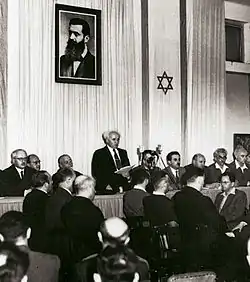
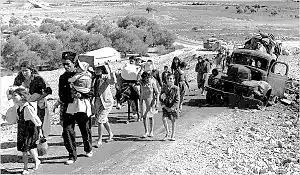
- 14 May 1948 – Israeli Declaration of Independence: the Jewish leadership in the region of Palestine announces the establishment of a Jewish state in Eretz-Israel, to be known as the State of Israel.[190]
- 14 May 1948 – 7 January 1949 – The 1948 Arab–Israeli War: a large-scale war between Israel and five Arab countries and the Palestinian-Arabs. The war resulted in an Israeli victory, with Israel annexing territory beyond the borders of the proposed Jewish state and into the borders of the proposed Arab state and West Jerusalem.[191] Jordan, Syria, Lebanon, and Egypt signed the 1949 Armistice Agreements with Israel. The Gaza Strip and the West Bank, were occupied by Egypt and Transjordan, respectively until 1967. In 1951, the UN Conciliation Commission for Palestine estimated that some 711,000 Palestinian refugees were displaced by the war.[192]
Israel, the Jordanian West Bank, and Egyptian occupation
- 24 February 1949 - Israel and Egypt signs an armistice agreement.[193]
- 23 March 1949 - Israel and Lebanon signs an armistice agreement.[193]
- 3 April 1949 - Israel and Jordan signs an armistice agreement.[193]
- 20 July 1949 - Israel and Syria signs an armistice agreement.[193]
- Spring 1950 - Jordan annexes the West Bank.[193]
- 29 October 1956 – 5 November 1956 – The Sinai Campaign was held. This war, followed Egypt's decision of 26 July 1956 to nationalize the Suez Canal. The war was initiated by United Kingdom and France, and conducted in cooperation with Israel, aimed at occupying the Sinai Peninsula, with the Europeans regaining control over the Suez Canal. Although the Israeli occupation of the Sinai was successful, the US and USSR forced it to abandon this conquest. However, Israel managed to re-open the Straits of Tiran and secured its southern border.
- 5–10 June 1967 – The Six-Day War took place and was fought between Israel and all of its neighboring countries: Egypt, Jordan, Syria and Lebanon, which were aided by other Arab countries. The war lasted six days and concluded with Israel expanding its territory significantly – Gaza Strip and Sinai from Egypt, the West Bank and Jerusalem from Jordan and the Golan Heights from Syria.
Israel and the occupied Palestinian territories
- 6–24 October 1973 – The Yom Kippur War was fought. The war began with a surprise joint attack on two fronts by the armies of Syria (in the Golan Heights) and Egypt (in the Suez Canal), deliberately initiated during the Jewish holiday of Yom Kippur. The Egyptian Army got back Sinai that was occupied by the Israeli armies for almost 7 years.
- 1974 – The PLO is allowed to represent the Palestinian Arab refugees in the UN as their sole political representative organisation.
- 18 September 1978 – Israel and Egypt sign a comprehensive peace agreement at Camp David which included a condition of Israel's withdrawal from the Rest of Sinai.
- 26 March 1979 – The peace treaty with Egypt was signed by the Israeli Prime Minister Menachem Begin, the Egyptian President Anwar Sadat and U.S. President Jimmy Carter.
- June–December 1982 – The First Lebanon War took place during which Israel invaded southern Lebanon due to the constant terror attacks on northern Israel by the Palestinian guerrilla organizations resident there. The war resulted in the expulsion of the PLO from Lebanon, and created an Israeli Security Zone in southern Lebanon.
- 21 November 1984 – January 5, 1985 – Operation Moses: IDF forces conduct a secret operation in which approximately 8,000 Ethiopian Jews were brought to Israel from Sudan.
- 15 November 1988-Palestinian Declaration of Independence (1988) – The Palestinian National Council, the legislative body of the Palestinian Liberation Organization (PLO), in Algiers on 15 November 1988 unilaterally proclaimed the establishment of a new independent state called the "State of Palestine".
- 1987–1991 – The First Intifada: The first Palestinian uprising took place in the Gaza Strip and the West Bank against the Israeli occupation of the Palestinian territories.
- 24–25 May 1991 – Operation Solomon: IDF forces conduct a secret operation in which approximately 14,400 Ethiopian Jews were brought to Israel within 34 hours in 30 IAF and El Al aircraft.

- 13 September 1993 – The first Oslo Accords are signed at an official ceremony in Washington in the presence of Yitzhak Rabin for Israel, Yasser Arafat for PLO and Bill Clinton for the United States.
- October 26, 1994 – The Peace agreement between Israel and Jordan is signed.
- 4 November 1995 – Israeli Prime Minister Yitzhak Rabin was assassinated by right-wing Israeli radical Yigal Amir.
- 2000–2005 (unclear) – The Second Intifada: The second Palestinian uprising took place in the Gaza Strip and the West Bank against the Israeli occupation of the Palestinian Territories. The uprising which began as massive protests carried out by Palestinians in the Palestinian Territories, soon turned into a violent Palestinian guerrilla campaign which included numerous suicide attacks carried out against Israeli civilians within the state of Israel.

- June 2002 – As a result of the significant increase of suicide bombing attacks within Israeli population centers during the first years of the Second Intifada, Israel began the construction of the West Bank Fence along the Green Line border arguing that the barrier is necessary to protect Israeli civilians from Palestinian militants. The significantly reduced number of incidents of suicide bombings from 2002 to 2005 has been partly attributed to the barrier.[194] The barrier's construction, which has been highly controversial, became a major issue of contention between the two sides.
- 23 August 2005 – Israel's unilateral disengagement plan: The evacuation of 25 Jewish settlements in the Gaza Strip and West Bank is completed.
- 12 July – 14 August 2006 – The Second Lebanon War took place, which began as a military operation in response to the abduction of two Israeli reserve soldiers by the Hezbollah, and gradually grew to a wider conflict. 1,191 Lebanese were killed, 4,409 were injured.
- 27 December 2008 – 18 January 2009 – Operation Cast Lead: IDF forces conducted a large-scale military operation in the Gaza Strip during which dozens of targets were attacked in the Gaza Strip in response to ongoing rocket fire on the western Negev. 1,291 Palestinians were killed.
- 14 November 2012 – 21 November 2012 – Operation Pillar of Cloud: IDF forces launches a large-scale military operation in the Gaza Strip in response to Palestinian militants firing over a hundred rockets from the Gaza Strip into southern Israel beginning on 10 November, with the aims of restoring quiet to southern Israel and to strike at what it considers terror organizations.[195] The operation officially began with the assassination of Ahmed Jabari, chief of the Gaza military wing of Hamas.[196] 158 Palestinians were killed.
- 29 November 2012 – United Nations General Assembly resolution 67/19: Upgrading of Palestine to non-member observer state status in the United Nations.[197]
- 23 December 2016 – United Nations Security Council resolution 2334: Condemning Israeli occupation of Palestinian lands.[198]
- 6 December 2017 - US President Donald Trump announced the United States recognition of Jerusalem as the capital of Israel.[199]
See also
Notes and references
Citations
- Vertebrates – dinosaurs – University of Copenhagen
- Discovery Online, Discovery News Brief
- Qesem Cave Project – Introduction
- Oxford University Press: 100 Decisive Battles: Paul K. Davis
- Joseph P. Free, Howard F. Vos. 1992. Archaeology and Bible history. p. 150. ISBN 978-0-310-47961-1
- Burgess, Henry (2003). Journal of Sacred Literature and Biblical Record, April 1855 to July 1855. Kessinger Publishing. ISBN 978-0-7661-5612-8.
- Wagemakers 2014, p. 219.
- Schwartz 2009, p. 53; Bourgel 2019, p. 2
- Gera 1998, p. 109.
- Lendering, Antiochus IV Epiphanes; Britannica, Antiochus IV Epiphanes
- Lendering, Antiochus IV Epiphanes.
- Britannica, Antiochus IV Epiphanes: In 172, for an even bigger tribute, he appointed Menelaus in place of Jason.
- Grabbe 2010, pp. 14-5; Britannica, Antiochus IV Epiphanes
- Grabbe 2010, p. 15; Morkholm 2008, p. 283
- Schäfer 2003, p. 40; Grabbe 2010, p. 15
- Morkholm 2008, p. 283.
- Morkholm 2008, p. 284; Grabbe 2010, p. 15
- Schwartz 2009, p. 54-5; Morkholm 2008, p. 286
- Schäfer 2003, p. 47; Morkholm 2008, p. 287
- Morkholm 2008, p. 289-90; Schäfer 2003, p. 47
- Morkholm 2008, p. 290
- Schwartz 2009, p. 33; Morkholm 2008, p. 290; Britannica, Antiochus IV Epiphanes: in December 164 was able to tear down the altar of Zeus and reconsecrate the Temple
- Morkholm 2008, p. 290.
- Schwartz 2009, p. 33.
- Schwartz 2009, p. 33; Bourgel 2019, p. 8
- Bourgel 2019, p. 8.
- Bourgel 2019, p. 10.
- Schwartz 2009, p. 37.
- Bourgel 2019, p. 9; Hjelm 2010, p. 28
- Schwartz 2009, p. 38; Hjelm 2010, p. 35
- Schwartz 2009, p. 38.
- Schwartz 2009, p. 42.
- Schwartz 2009, p. 45.
- Meyers & Chancey 2012, p. 50.
- Greetham, The Rev. Phil. "King Herod the Great." "The Nativity Pages". Archived from the original on 2012-07-23., 2001.
- Richardson 1996, p. 344.
- Chancey 2005, p. 74.
- Magness 2012, p. 133.
- Richardson 1996, p. 303; Magness 2012, p. 133
- Menahem MANṠŪR (1964). The Dead Sea Scrolls: A College Textbook and a Study Guide. Brill Archive. p. 14. GGKEY:EP1DFQRSATU.
- Sebaste, Holy Land Atlas Travel and Tourism Agency.
- "Entry for Herod." The Jewish Virtual Library, American-Jewish Cooperative Enterprise, 2007. Retrieved June 18, 2007.
- Meyers & Chancey 2012, p. 62.
- Richardson 1996, p. 282.
- Millar 1993, p. 354.
- Temple of Herod, Jewish Encyclopedia
- Richardson 1996, p. 265.
- Richardson 1996, p. 363.
- Rahner (page 731) states that the consensus among historians is c. 4 BCE . Sanders supports c. 4 BCE . Vermes supports c. 6/5 BCE . Finegan supports c. 3/2 BCE . Sanders refers to the general consensus, Vermes a common 'early' date, Finegan defends comprehensively the date according to early Christian traditions.
- Schwartz 2009, p. 48.
- Haensch 2010, p. 2; Ben-Sasson 1976, p. 246: When Archelaus was deposed from the ethnarchy in 6 CE, Judea proper, Samaria and Idumea were converted into a Roman province under the name Iudaea.; Schwartz 2009, p. 48
- Millar 1993, p. 346.
- Chancey 2005, p. 86.
- Magness 2012, p. 138.
- Haensch 2010, p. 2; Millar 1993, p. 356
- Haensch 2010, p. 2; Magness 2012, p. 139
- Magness 2012, p. 139.
- Chancey 2005, p. 78; McLaren & Goodman 2016, p. 215; Schwartz 2009, p. 47
- Haensch 2010, p. 2; Chancey 2005, p. 71
- Schwartz 2009, p. 52.
- Magness 2012, p. 140.
- Millar 1993, p. 366.
- Schwartz 2016, p. 234.
- Chancey 2005, p. 62; Millar 1993, p. 371
- Bonne 2014, p. 1.
- Chancey 2005, p. 103.
- Weksler-Bdolah 2019, p. 53.
- Weksler-Bdolah 2019, p. 58.
- Chancey 2005, p. 62; Schwartz 2016, p. 238; Weksler-Bdolah 2019, p. 53
- Donaldson 2000, p. 127; Viviano 2007, p. 17
- Viviano 2007, p. 17.
- Slavik 2001, p. 60.
- Lewin 2005, p. 39.
- Lewin 2005, p. 36; Bijovsky 2007, p. 182
- Moser 2018, p. 225.
- Lewin 2005, p. 38.
- Lewin 2005, p. 38; Bijovsky 2007, p. 182
- Lewis 2011, p. 155.
- Sivan 2008, p. 213.
- Donaldson 2000, p. 128; Viviano 2007, p. 17
- Lewin 2005, pp. 40-1.
- Lewin 2005, p. 41; Stewart Evans 2005, p. 26
- Stewart Evans 2005, p. 26.
- Lewin 2005, p. 41; Stewart Evans 2005, p. 26; Sivan 2008, pp. 141-2
- Dignas & Winter 2007, p. 117.
- Schäfer 2003, p. 198.
- Kaegi 1992, p. 93.
- Kaegi 1992, p. 146.
- Schäfer 2003, p. 198: the capture of Jerusalem in 638; Dignas & Winter 2007, p. 49: The conquerors had already taken Damascus in 635, and in 637 Jerusalem fell.
- Avni 2014, p. 325.
- Masalha 2018, p. 155.
- Olszowy-Schlanger 1998, p. 55; Meri 2006, p. 590
- Gil 1997, p. 841.
- Barkat, Amiram (August 8, 2003). "The big one is coming". Haaretz. Retrieved May 11, 2011.
- Avni 2014, p. 325; Gil 1997, p. 89
- Meri 2006, p. 1.
- Gil 1997, pp. 297-8,842.
- Gil 1997, p. 279.
- Gil 1997, p. 283,842.
- Gil 1997, p. 284.
- Khadduri 2006, p. 248.
- Goitein & Grabar 2007, p. 230.
- Khadduri 2006, p. 248; Jotischky 2016, p. 53
- Gil 1997, p. 283.
- Pringle 1993, p. 10.
- Gil 1997, p. 844.
- Gil 1997, p. 843.
- Burke & Peilstocker 2011, p. 114.
- Burke & Peilstocker 2011, p. 114; Goitein & Grabar 2007, p. 231
- Gil 1997, p. 845.
- Jotischky 2016, p. 54.
- Janin 2015, p. 76.
- Gil 1997, p. 162.
- Gil 1997, p. 848; Pringle 1993, p. 10
- Gil 1997, p. 848.
- Gil 1997, p. 849.
- Pringle 1993, p. 10; Goitein & Grabar 2007, p. 232
- Gil 1997, p. 339.
- Kennedy 2004, p. 277; Harris 2014, p. 29
- Gil 1997, p. 343.
- Gil 1997, p. 344.
- Gil 1997, p. 851.
- Kennedy 2004, p. 322; Gil 1997, p. 851
- Gil 1997, p. 354.
- Gil 1997, p. 355.
- Gil 1997, pp. 358,851.
- Gil 1997, p. 366.
- Gil 1997, p. 369-70.
- Janin 2015, p. 77.
- Lev 2006, p. 592; Jotischky 2016, p. 50; Janin 2015, p. 77
- Gil 1997, p. 853; Burke & Peilstocker 2011, p. 116; Pringle 1993, p. 11
- Gil 1997, p. 853.
- Gil 1997, p. 854.
- Gil 1997, p. 386.
- Masalha 2018, p. 185; Lev 2006, p. 591; Burke & Peilstocker 2011, p. 174
- Jotischky 2016, p. 55.
- Harris 2014, p. 29; Preiser-Kapeller 2021, p. 165
- Lev 2006, p. 591.
- Gil 1997, p. 397.
- Gil 1997, p. 398.
- Avni 2014, p. 325; Lev 2006, p. 592; Burke & Peilstocker 2011, p. 116; Gil 1997, p. 399
- Lev 2006, p. 591; Pringle 1993, p. 12
- Goitein & Grabar 2007, p. 233.
- Janin 2015, p. 83.
- Avni 2014, p. 325; Lev 2006, p. 592; Gil 1997, p. 408
- Burke & Peilstocker 2011, p. 116.
- Masalha 2018, p. 186.
- Gil 1997, p. 415.
- Gil 1997, p. 419.
- Lev 2006, p. 592.
- Burke & Peilstocker 2011, p. 117.
- Gil 1997, p. 414.
- Jotischky 2017, p. 56; Asbridge 2004, pp. 298, 309
- Barber 2012, p. 358.
- Asbridge 2004, p. 304.
- Chareyron 2005, p. 79; Pringle 1993, p. 12
- Asbridge 2004, p. 321.
- Barber 2012, p. 19.
- Hickman 2019.
- Britannica, Palestine - The Crusades.
- Boas 2001, p. 44.
- Lock 2006, p. 53.
- Baldwin 1969, p. 538.
- Meri 2006, p. 591.
- Chareyron 2005, p. 79; Avni 2014, p. 336; Jotischky 2016, p. 49
- Asbridge 2010, p. 564.
- Britannica, Crusades; Asbridge 2010, p. 564
- Britannica, Crusades; Asbridge 2010, p. 564
- Britannica, Crusades; Asbridge 2010, p. 564
- Britannica, Crusades.
- Britannica, Crusades; Asbridge 2010, p. 564; Tyerman 2006, p. 472; Maalouf 1984, pp. 216-218
- Boas 2001, p. 45.
- Boas 2001, p. 45; Madden 2014, p. 141
- Britannica, Palestine - The Crusades; Asbridge 2010, p. 469
- Asbridge 2010, p. 470.
- Asbridge 2010, p. 474.
- Asbridge 2010, p. 475.
- Chareyron 2005, p. 82.
- Roth 2014, p. 622.
- Farsoun 2004, p. 8.
- Abu-Husayn, Abdul-Rahim (2004). The view from Istanbul: Lebanon and the Druze Emirate in the Ottoman chancery documents, 1546–1711. I.B.Tauris. pp. 22–23. ISBN 978-1-86064-856-4.
- Barnai, Jacob. The Jews in Palestine in the Eighteenth Century: under the patronage of the Istanbul Committee of Officials for Palestine (University of Alabama Press 1992) ISBN 978-0-8173-0572-7; p. 14
- Joel Rappel. History of Eretz Israel from Prehistory up to 1882 (1980), Vol.2, p.531. "In 1662 Sabbathai Sevi arrived to Jerusalem. It was the time when the Jewish settlements of Galilee were destroyed by the Druze: Tiberias was completely desolate and only a few of former Safed residents had returned..."
- Gershom Gerhard Scholem (1976-01-01). Sabbatai Sevi: the Mystical Messiah, 1626–1676. Princeton University Press. p. 368. ISBN 978-0-691-01809-6.
In Safed, too, the [Sabbatai] movement gathered strength during the autumn of 1665. The reports about the utter destruction, in 1662 [sic], of the Jewish settlement there seem greatly exaggerated, and the conclusions based on them are false. ... Rosanes' account of the destruction of the Safed community is based on a misunderstanding of his sources; the community declined in numbers but continued to exist ... A very lively account of the Jewish community is given by French trader d'Arvieux who visited Safed in 1660.
- Sbeinati, M.R., Darawcheh, R. & Mouty, M. 2005. The historical earthquakes of Syria: an analysis of large and moderate earthquakes from 1365 B.C. to 1900 A.D. Annals of Geophysics, 48, 347–435.
- Mishkenot Sha'ananim
- Lewis 2011, p. 158.
- Friedman, Isaiah (1971). German Intervention on Behalf of the "Yishuv", 1917 , Jewish Social Studies, Vol. 33, pp. 23–43.
- Lewis 2011, p. 163.
- Provisional Government of Israel: Official Gazette: Number 1; Tel Aviv, 5 Iyar 5708, 14.5.1948 Page 1: The Declaration of the Establishment of the State of Israel
- Baylis Thomas (1999) How Israel was won: a concise history of the Arab-Israeli conflict Lexington Books, ISBN 0-7391-0064-5 p xiv
- General Progress Report and Supplementary Report of the United Nations Conciliation Commission for Palestine, Covering the Period from 11 December 1949 to 23 October 1950 Archived 20 May 2014 at the Wayback Machine, published by the United Nations Conciliation Commission, 23 October 1950. (U.N. General Assembly Official Records, 5th Session, Supplement No. 18, Document A/1367/Rev. 1: Retrieved 5 January 2015)]
- Lewis 2011, p. 164.
- Nissenbaum, Dion (January 10, 2007). "Death toll of Israeli civilians killed by Palestinians hit a low in 3015". Washington Bureau. McClatchy Newspapers. Archived from the original on November 20, 2008. Retrieved April 16, 2007.
Fewer Israeli civilians died in Palestinian attacks in 2006 than in any year since the Palestinian uprising began in 2000. Palestinian militants killed 23 Israelis and foreign visitors in 2006, down from a high of 289 in 2002 during the height of the uprising. Most significant, successful suicide bombings in Israel nearly came to a halt. Last year, only two Palestinian suicide bombers managed to sneak into Israel for attacks that killed 11 people and wounded 30 others. Israel has gone nearly nine months without a suicide bombing inside its borders, the longest period without such an attack since 2000[...] An Israeli military spokeswoman said one major factor in that success had been Israel's controversial separation barrier, a still-growing 250-mile (400 km) network of concrete walls, high-tech fencing and other obstacles that cuts through parts of the West Bank. ‘The security fence was put up to stop terror, and that's what it's doing,’ said Capt. Noa Meir, a spokeswoman for the Israel Defense Forces. [...] Opponents of the wall grudgingly acknowledge that it's been effective in stopping bombers, though they complain that its route should have followed the border between Israel and the Palestinian territories known as the Green Line. [...] IDF spokeswoman Meir said Israeli military operations that disrupted militants planning attacks from the West Bank also deserved credit for the drop in Israeli fatalities.
- "IAF strike kills Hamas military chief Jabari - Defense - Jerusalem Post".
- "Massed Israeli troops poised for invasion of Gaza". 2012-11-15.
- Resolution adopted by the General Assembly on 29 November 2012: without reference to a Main Committee (A/67/L.28 and Add.1): 67/19. Status of Palestine in the United Nations
- "Resolution 2334". unscr.com. Retrieved 2019-01-24.
- Proclamation 9683 of December 6, 2017, 82 FR 58331
Sources
- Haensch, Rudolf (August 19, 2010). "The Roman Provincial Administration". In Catherine Hezser (ed.). The Oxford Handbook of Jewish Daily Life in Roman Palestine. OUP Oxford. pp. 1–13. ISBN 978-0-19-921643-7.
- Ben-Sasson, H.H. (1976). Abraham Malamat; Hayim Tadmor (eds.). A History of the Jewish People. Harvard University Press. ISBN 978-0-674-39731-6.
- Chancey, Mark A. (December 15, 2005). Greco-Roman Culture and the Galilee of Jesus. Cambridge University Press. ISBN 978-1-139-44798-0.
- Meyers, Eric M.; Chancey, Mark A. (September 25, 2012). Alexander to Constantine: Archaeology of the Land of the Bible, Volume III. Yale University Press. ISBN 0-300-14179-3.
- Chareyron, Nicole (March 2, 2005). Pilgrims to Jerusalem in the Middle Ages. Columbia University Press. ISBN 978-0-231-52961-7.
Ancient history
- Masalha, Nur (2018). Palestine: A Four Thousand Year History. Bloomsbury Academic. ISBN 978-1-78699-274-1.
- Viviano, Benedict (2007). Matthew and His World: The Gospel of the Open Jewish Christians : Studies in Biblical Theology. Vandenhoeck & Ruprecht. ISBN 978-3-7278-1584-3.
- Donaldson, Terence L. (May 11, 2000). Religious Rivalries and the Struggle for Success in Caesarea Maritima. Wilfrid Laurier Univ. Press. ISBN 978-1-55458-670-7.
- Schäfer, Peter (2003). The History of the Jews in the Greco-Roman World. Psychology Press. ISBN 978-0-415-30585-3.
- Schwartz, Seth (February 9, 2009). Imperialism and Jewish Society: 200 B.C.E. to 640 C.E. Princeton University Press. ISBN 1-4008-2485-0.
- Magness, Jodi (August 27, 2012). The Archaeology of the Holy Land: From the Destruction of Solomon's Temple to the Muslim Conquest. Cambridge University Press. ISBN 978-0-521-12413-3.
- Hjelm, Ingrid (2010). "Mt. Gerizim and Samaritans in Recent Research". In Waltraud Winkler (ed.). Samaritans: Past and Present : Current Studies. Walter de Gruyter. pp. 25–44. ISBN 978-3-11-019497-5.
- Wagemakers, Bart (February 28, 2014). Archaeology in the 'Land of Tells and Ruins': A History of Excavations in the Holy Land Inspired by the Photographs and Accounts of Leo Boer. Oxbow Books. pp. 219–. ISBN 978-1-78297-245-7.
- Avni, Gideon (2014). The Byzantine-Islamic Transition in Palestine: An Archaeological Approach. OUP Oxford. pp. 325–. ISBN 978-0-19-968433-5.
Hellenistic period
- Lendering, Jona (September 24, 2020). "Antiochus IV Epiphanes". Livius. Retrieved January 21, 2021.
- Grabbe, Lester L. (August 12, 2010). An Introduction to Second Temple Judaism: History and Religion of the Jews in the Time of Nehemiah, the Maccabees, Hillel, and Jesus. A&C Black. ISBN 978-0-567-55248-8.
- Bourgel, Jonathan (2019). "The Samaritans during the Hasmonean Period: The Affirmation of a Discrete Identity?". Religions. 10 (11). doi:10.3390/rel10110628. ISSN 2077-1444.
- Morkholm, Otto (2008). "Antiochus IV". In William David Davies; Louis Finkelstein (eds.). The Cambridge History of Judaism: Volume 2, The Hellenistic Age. Cambridge University Press. pp. 278–291. ISBN 978-0-521-21929-7.
- "Antiochus IV Epiphanes - Biography, Reign, Jerusalem, Revolt, & Death". Encyclopedia Britannica. January 5, 2021.
- Gera, Dov (1998). Judaea and Mediterranean Politics: 219 to 161 B.C.E. BRILL. ISBN 90-04-09441-5.
Roman period
- McLaren, James; Goodman, Martin (August 25, 2016). "The Importance of Perspective: The Jewish-Roman Conflict of 66–70 CE as a Revolution". Revolt and Resistance in the Ancient Classical World and the Near East: In the Crucible of Empire. BRILL. pp. 205–218. ISBN 978-90-04-33018-4.
- Schwartz, Seth (August 25, 2016). "The Impact of the Jewish Rebellions, 66–135 CE: Destruction or Provincialization?". Revolt and Resistance in the Ancient Classical World and the Near East: In the Crucible of Empire. BRILL. pp. 234–252. ISBN 978-90-04-33018-4.
- Lendering, Jona (October 10, 2020). "Herod the Great". Livius. Retrieved December 19, 2020.
- Gabba, Emilio (2008). "The social, economic and political history of Palestine 63 bce – ce 70". In William David Davies; Louis Finkelstein; William Horbury (eds.). The Cambridge History of Judaism: The early Roman period. Cambridge University Press. pp. 94–167. ISBN 978-0-521-24377-3.
- Weksler-Bdolah, Shlomit (December 16, 2019). Aelia Capitolina – Jerusalem in the Roman Period: In Light of Archaeological Research. BRILL. ISBN 978-90-04-41707-6.
- Millar, Fergus (1993). The Roman Near East, 31 B.C.-A.D. 337. Harvard University Press. ISBN 978-0-674-77886-3.
- Bonne, Rick (April 2014). Galilee during the Second Century AD: An Archaeological Examination of a Period of Socio-Cultural Change (Thesis). KU Leuven.
- Richardson, Peter (1996). Herod: King of the Jews and Friend of the Romans. Univ of South Carolina Press. ISBN 978-1-57003-136-6.
- Lewin, Ariel (2005). The Archaeology of Ancient Judea and Palestine. Getty Publications. ISBN 978-0-89236-800-6.
- Dignas, Beate; Winter, Engelbert (2007) [2001]. Rome and Persia in Late Antiquity: Neighbours and Rivals. Cambridge University Press. ISBN 978-0-521-84925-8.
Byzantine period
- Slavik, Diane (2001). Daily Life in Ancient and Modern Jerusalem. Lerner Publications. ISBN 978-0-8225-3218-7.
- Stewart Evans, James Allan (2005). The Emperor Justinian and the Byzantine Empire. Greenwood Publishing Group. pp. 26–. ISBN 978-0-313-32582-3.
- Bijovsky, Gabriela (2007). "Numismatic Evidence for the Gallus Revolt: The Hoard from Lod". Israel Exploration Journal. 57 (2): 187–203.
- Moser, Muriel (December 6, 2018). Emperor and Senators in the Reign of Constantius II. Cambridge University Press. ISBN 978-1-108-48101-4.
- Lewis, Bernard (April 15, 2011). Islam in History: Ideas, People, and Events in the Middle East. Open Court. ISBN 978-0-8126-9757-5.
- Sivan, Hagith (February 14, 2008). Palestine in Late Antiquity. OUP Oxford. ISBN 978-0-19-160867-4.
Early Muslim period
- Goitein, S.D.; Grabar, O. (2007). "Jerusalem". In Clifford Edmund Bosworth (ed.). Historic Cities of the Islamic World. BRILL. pp. 224–255. ISBN 90-04-15388-8.
- Pringle, Denys (1993). The Churches of the Crusader Kingdom of Jerusalem: Volume 3, The City of Jerusalem: A Corpus. Cambridge University Press. ISBN 978-0-521-39038-5.
- Harris, Jonathan (2014). Byzantium and the Crusades. Bloomsbury Publishing. ISBN 978-1-78093-671-0.
- Preiser-Kapeller, Johannes (2021). "The Medieval Roman Empire of the East as a Spatial Phenomenon". In Yuri Pines; Michal Biran; Jörg Rüpke (eds.). The Limits of Universal Rule: Eurasian Empires Compared. Cambridge University Press. ISBN 978-1-108-48863-1.
- Kennedy, Hugh N. (2004). The Prophet and the Age of the Caliphates: The Islamic Near East from the 6th to the 11th Century (Second ed.). Harlow: Pearson Education Limited. ISBN 0-582-40525-4.
- Jotischky, Andrew (2016). Benjamin Z. Kedar; Jonathan Phillips; Jonathan Riley-Smith (eds.). Crusades: Volume 7. Taylor & Francis. ISBN 978-1-351-98557-4.
- Kaegi, Walter E. (1992). Byzantium and the early Islamic conquests. Cambridge, UK: Cambridge University Press. ISBN 0-521-41172-6.
- Lev, Yaacov (2006). "Palestine". In Josef W. Meri (ed.). Medieval Islamic Civilization: L-Z, index. Taylor & Francis. pp. 590–2. ISBN 978-0-415-96692-4.
- Meri, Josef W. (2006). Medieval Islamic Civilization: L-Z, index. Taylor & Francis. ISBN 978-0-415-96692-4.
- Gil, Moshe (1997). A History of Palestine, 634-1099. Cambridge University Press. ISBN 978-0-521-59984-9.
- Olszowy-Schlanger, Judith (1998). Karaite Marriage Documents from the Cairo Geniza: Legal Tradition and Community Life in Mediaeval Egypt and Palestine. BRILL. pp. 55–. ISBN 90-04-10886-6.
- Burke, Aaron A; Peilstocker, Martin (2011). The History and Archaeology of Jaffa 1. Cotsen Institute of Archaeology Press. ISBN 978-1-938770-56-2.
- Khadduri, Majid (2006). War and Peace in the Law of Islam. The Lawbook Exchange, Ltd. ISBN 978-1-58477-695-6.
- Janin, Hunt (2015). Four Paths to Jerusalem: Jewish, Christian, Muslim, and Secular Pilgrimages, 1000 BCE to 2001 CE. McFarland. ISBN 978-1-4766-0880-8.
Crusader period
- Tyerman, Christopher (2006). God's War: A New History of the Crusades. The Belknap Press of Harvard University Press. ISBN 978-0-674-02387-1.
- Maalouf, Amin (1984). The Crusades Through Arab Eyes. SAQI. ISBN 978-0-86356-023-1.
- Asbridge, Thomas (2004). The First Crusade: A New History. Simon&Schuster. ISBN 978-0-7432-2084-2.
- Lock, Peter (2006). The Routledge Companion to the Crusades. Routledge. ISBN 9-78-0-415-39312-6.
- Barber, Malcolm (2012). The Crusader States. Yale University Press. ISBN 978-0-300-11312-9.
- Baldwin, Marshall W. (1969). "The Latin States under Baldwin III and Amalric I, 1143–1174; The Decline and Fall of Jerusalem, 1174–1189". In Setton, Kenneth M.; Baldwin, Marshall W. (eds.). A History of the Crusades, Volume One: The First Hundred Years. The University of Wisconsin Press. pp. 528–561, 590–621. ISBN 1-58684-251-X.
- Jotischky, Andrew (2017). Crusading and the Crusader States. Routledge. ISBN 978-1-138-80806-5.
- Hickman, Kennedy (October 15, 2019). "The Crusades: Battle of Ascalon". ThoughtCo. Retrieved January 19, 2021.
- "Palestine - The Crusades". Encyclopedia Britannica. Retrieved January 21, 2021.
- "Crusades". Encyclopedia Britannica. December 29, 2020. Retrieved January 24, 2021.
- Asbridge, Thomas (2010). The Crusades: The Authoritative History of the War for the Holy Land. HarperCollins e-books. ISBN 978-0-06-198136-4.
- Roth, Norman (2014). Medieval Jewish Civilization: An Encyclopedia. Routledge. ISBN 978-1-136-77155-2.
- Boas, Adrian J. (2001). Jerusalem in the Time of the Crusades: Society, Landscape and Art in the Holy City Under Frankish Rule. Routledge. ISBN 978-1-134-58272-3.
- Madden, Thomas F. (2014). The Concise History of the Crusades. Rowman & Littlefield Publishers. ISBN 978-1-4422-3116-0.
Ottoman period
- Farsoun, Samih K. (2004). Culture and Customs of the Palestinians. Greenwood Publishing Group. ISBN 978-0-313-32051-4.
Further reading
- Philip Mattar (2005). "Chronology". Encyclopedia of the Palestinians. Facts on File. ISBN 978-0-8160-6986-6.
External links
- "Timeline: Palestinian Territories". Discoverislamicart.org. Vienna: Museum With No Frontiers.

